
Explore Bundi – The Secret Heritage Town of Rajasthan
Top attractions, stays & travel tips for your Bundi trip.
Bundi — The City of Stepwells and Royal Reflections
Tucked away in the heart of Rajasthan, far from the roar of tourist trails, lies Bundi — a canvas of time-worn walls and whispered tales. Away from Jaipur’s glitter, Udaipur’s lakes, Jodhpur’s blues, and Pushkar’s prayers, Bundi moves at its own rhythm — slow, soulful, and scented with stories of old.
Once the proud seat of the Hada Chauhans, Bundi still wears its medieval charm like an heirloom shawl — frayed at the edges, yet rich with warmth. Bundi holds the kind of magic that modern India sometimes forgets.
The forts and palaces of Bundi rise from the Aravalli hills like stories carved in stone. At the top, Taragarh Fort keeps a quiet watch over the town’s blue lanes, while the walls of Bundi Palace and its Chitrashala still murmur tales in faded colors.
It’s easy to see why Rudyard Kipling fell under Bundi’s spell: “The Palace of Bundi... is such a palace as men build for themselves in uneasy dreams — the work of goblins rather than of men.”
Wander deeper and you’ll feel the heartbeat of Bundi — in its stepwells carved like songs of stone, in the quiet blue houses that cool both walls and souls, in the bazaars that hum softly beneath the fort’s gaze.
Unlike Rajasthan’s bustling cities, Bundi doesn’t shout to be seen. It invites you to slow down, to wander, to listen. It’s Rajasthan without the rush — a pause between two grand verses, a dream caught in daylight.
And truly, Bundi feels like that — half memory, half mirage, wholly magic.
Updated on: 02nd, Nov 2025
Explored on: Oct' 2025
How to Reach Bundi - Finding Rajasthan’s Best-Kept Secret
Tucked away in the Hadoti region of Rajasthan, Bundi feels blissfully off the map yet surprisingly easy to reach. Whether you choose to fly, drive, or ride the rails, the journey to Bundi is scenic, simple, and full of Rajasthan’s changing moods.
By Air
The nearest airport is Jaipur International Airport, about 210 kilometers from Bundi. From Jaipur, you can hire a private cab or catch a state bus — the drive takes around four to five hours, passing through quiet villages, open fields, and sunlit roads. It’s a perfect prelude to Bundi’s old-world calm.
By Train
Bundi Railway Station lies just 4 km from the town center, linked to Kota, Udaipur, and Chittorgarh. For faster connections, Kota Junction (35 km away) is the nearest major rail hub, with regular trains from Delhi, Mumbai, and other big cities. From Kota, you can easily reach Bundi by taxi or local bus, making this the most convenient option for many travelers.
By Road
Bundi is well connected by road to Jaipur, Udaipur, Indore, and Kota. The highways are smooth, dotted with friendly dhabas serving hot chai and simple meals. Regular Rajasthan Roadways and private buses run daily, offering both budget and comfortable travel choices.
No matter how you arrive, the road to Bundi is part of its charm. As you approach, the Aravalli hills begin to rise, the air grows quieter, and the silhouette of Taragarh Fort greets you from afar — a timeless welcome to this hidden gem of Rajasthan.
Best Time to Visit Bundi — When the Blue Town Shines Brightest
The best time to visit Bundi is between October and March, when the air is cool, the light is golden, and the town’s blue walls shimmer under a soft winter sun. During these months, Bundi’s weather feels like an invitation — perfect for slow travel, easy walks, and lingering by stepwells or lakes without the summer’s harsh heat.
Winter (October – March)
Cool mornings, soft sunlight, and perfect Bundi weather make winter the ideal season. You can climb Taragarh Fort, explore Bundi Palace, and linger by Nawal Sagar Lake without the heat. Temperatures stay around 10°C to 25°C, perfect for sightseeing and photography.
Summer (April – June)
Bundi turns warm and quiet in summer, with temperatures near 40°C. The afternoons can be harsh, but the streets are empty and peaceful — ideal for travelers who prefer slow moments and solitude. Start early, rest by noon, and enjoy Bundi’s golden hush.
Monsoon (July – September)
Monsoon paints Bundi green. The Aravalli hills bloom, waterfalls spill down, and the Stepwells brim with rainwater. While the paths to Taragarh Fort can be slippery, this season is perfect for photography — the town glows under mist and cloud.
In short, Winter is best, monsoon is magical, and summer is serene in its stillness. No matter when you arrive, Bundi will meet you with quiet beauty and timeless grace.
When it comes to places to stay, Bundi has something for every traveler — from elegant heritage havelis to friendly backpacker hostels. Whether you want royal courtyards or rooftop sunsets, Bundi’s stays reflect its soul: old-world charm with quiet comfort.
Luxury Stays in Bundi
Classic Sapphire Ananta – A modern retreat on Bundi’s edge, with spacious rooms, a serene pool, and sweeping Aravalli views. Perfect for travelers who love comfort wrapped in calm.
Haveli Braj Bhushanjee Heritage Hotel & Museum – A lovingly restored 200-year-old haveli that doubles as a living museum. Antique collections, royal arches, and fort-facing terraces make this one of the best heritage hotels in Bundi Rajasthan.
Mid-Range Heritage Hotels
Dev Niwas – A 17th-century haveli with airy rooms, a rooftop restaurant, and panoramic views of Bundi’s blue rooftops.
Ishwari Niwas – Once a royal guesthouse, now a graceful heritage hotel in Bundi, known for its colonial touch and peaceful gardens.
Haveli Bundi Inn – A cozy, family-run stay offering traditional decor, fort views, and a personal touch that makes you feel at home.
Hotel Bundi Haveli – Ideally located near the palace, this quiet retreat combines heritage charm with great rooftop dining and easy access to Bundi’s main attractions.
Budget & Backpacker Stays
Zostel Bundi – A colorful, social backpacker hostel in Bundi with fort views, comfy dorms, and a lively rooftop café that hums with stories from the road.
Haveli Uma Megh Tourist Guest House – A warm, family-run guesthouse offering clean rooms, home-cooked meals, and genuine Rajasthani hospitality — a perfect pick for budget travelers in Bundi.
No matter your budget, Bundi’s charm stays close — narrow blue lanes, hand-painted walls, and the timeless silhouette of Taragarh Fort keeping quiet watch above.
Where to Stay in Bundi — From Havelis to Hill Views


Blue town dreaming, quiet and old,
Whispers of stone, stories untold.
By Nawal Sagar, still skies gleam,
Fort in the water, mirrors a dream.
Garh Palace hums through arches wide,
Echoes of royals that time can't hide.
Chitrashala's walls in colors breathe,
Krishna and Radha in rhythm beneath.
Miniature worlds in colors bright,
Bundi's brushes bring tales to light.
At Krishna's Chai, the world slows down,
Tea and laughter in a humble town.
Raniji's steps where shadows fall,
Carved grace cooling Bundi's hall.
By Sukh Mahal, where breezes roam,
The lake sings low — Bundi feels like home.
Bundi Travel Guide and Itinerary — Forts, Stepwells, and Timeless Charm
Many travelers visit Bundi Rajasthan as a quick day trip — and while it’s possible to see the main sights in a single day, Bundi deserves more. To truly feel its rhythm — to hear echoes from its stepwells, watch the sun fade over Taragarh Fort, and lose yourself in its painted blue lanes — spend at least two days here.
This Bundi travel guide and itinerary help you discover the town’s dual charm — royal grandeur wrapped in rustic simplicity — making Bundi one of Rajasthan’s most poetic escapes.
Most of the best places to visit in Bundi lie within the old city, close enough to explore in a day. The old town is a maze of narrow, winding lanes — colorful, chaotic, and endlessly charming. The best way to get around is by tuk-tuk, letting you glide through Bundi’s blue alleys like a local.
Start early, when soft light touches the fort walls and the town begins to stir. It’s the perfect time to pause, to watch Bundi come alive — slow, serene, and full of quiet stories waiting to be found.
Begin your Bundi journey at the calm heart of the town — the shimmering Nawal Sagar Lake. This man-made lake sits at the very core of Bundi city, reflecting both its history and its soul. It’s one of the most Instagrammable spots in Bundi, and if you’ve ever searched “Bundi Rajasthan,” chances are you’ve seen its most famous image — the mighty Taragarh Fort rising high above, mirrored perfectly in the still waters below.
Built during the reign of Maharaja Nawal Singh in the 17th century, the lake was originally created to store water for Bundi’s people during dry months. Over time, it became more than just a reservoir — it turned into a symbol of Bundi’s royal heritage and architectural grace.
Surrounding the lake are some of the town’s most striking landmarks — Bundi Palace, old havelis, and small temples — their reflections creating a living painting on the water’s surface. The view at sunrise or sunset is pure poetry: the sky blushing gold, the fort glowing amber, and the lake holding it all like a mirror of time.
At its center stands a Small, Half-Submerged Temple dedicated to Lord Varuna, the Hindu god of water. Despite being partially underwater, the shrine remains an important place of faith and fascination — visited by both devotees and travelers who come to watch the temple’s silhouette shimmer over the ripples.
A visit to Nawal Sagar Lake is the perfect way to start your Bundi sightseeing — quiet, reflective, and beautifully symbolic of everything Bundi stands for: history, harmony, and hidden beauty.
Nawal Sagar Lake — Reflections of Royal Bundi

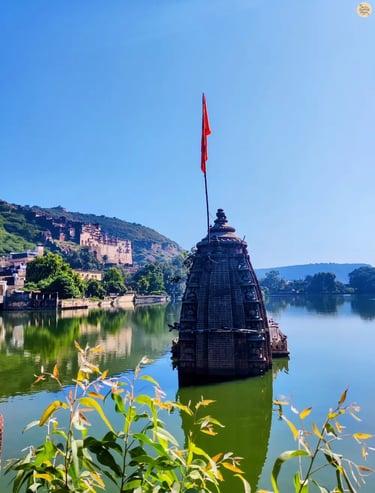
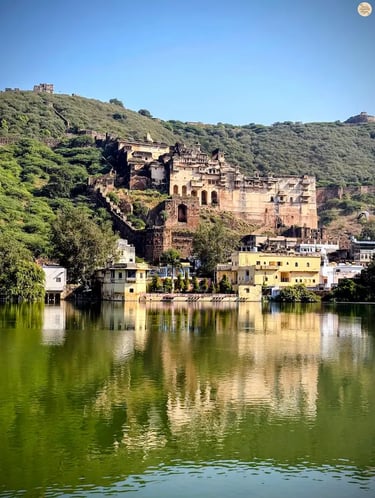


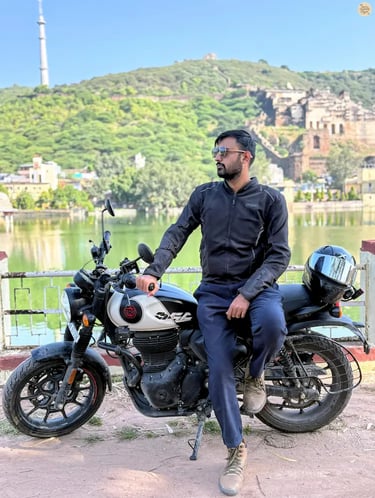
The Floating Shrine of Nawal Sagar
Bundi’s Beauty in One Frame
Framed by Fort and Lake
A short ride from Nawal Sagar Lake, past faded havelis and sunlit lanes, brings you to the crown of Bundi Rajasthan — the magnificent Taragarh Fort. Perched high on a hill, this ancient stronghold watches over the town like a guardian of time. There’s ample parking outside, and the short walk up is worth every step for the views that await.
Rudyard Kipling once said, “This is more the work of goblins than of men.” He wasn’t exaggerating. The fort, with its sprawling walls and mystical air, truly feels carved out of dreams. Built by Rao Deva Hada in 1298 AD and expanded by Rao Raja Bar Singh Hada in 1354 AD, Taragarh Fort Bundi has grown layer by layer — a living timeline of the Hada dynasty’s might and imagination.
After buying your ticket, you enter a vast, open courtyard — silent, sun-washed, and grand. From here, the fort’s massive bastions and ancient walls spread across the hillside, whispering stories of kings, wars, and royal life long gone.
Taragarh Fort can be explored in three main sections:
As you climb the steep cobblestone ramp, you’ll reach a fork — one path leads to Garh Palace, the other to Chitrashala and the upper ruins. Take your time; the fort isn’t just a monument, it’s a mood — wild, weathered, and wondrously alive.
Taragarh Fort — The Hilltop Crown of Bundi
🕒 Taragarh Fort Bundi Palace Timings & Entry Fee
Timings: Daily 9:00 AM – 6:00 PM
Entry Fee:
Foreign Tourists: ₹600
Indian Tourists: ₹100 (for adults and children above 12 years)
💡 Note: This is a composite ticket that includes entry to Taragarh Fort, Bundi Palace, and Kshar Bagh.
Standing like a carved dream against the hillside, Garh Palace is the grand centerpiece of Taragarh Fort Bundi — a maze of palaces, courtyards, and royal chambers rising layer by layer. From the city below, its honeyed sandstone walls gleam in the sun, echoing centuries of Bundi’s royal past.
Once worn by time and bats, this architectural marvel has recently been lovingly restored by the royal family of Bundi. Many sections are now open again, allowing travelers to wander through its forgotten beauty — from frescoed halls to stone balconies that overlook the blue town below.
Garh Palace — The Living Heart of Taragarh Fort
Bundi’s Crown of Stone

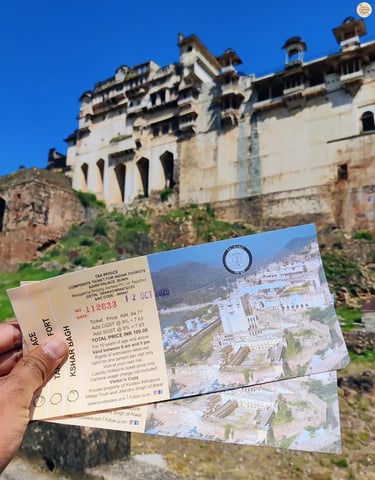
Your climb to Garh Palace ends at Hathi Pol or Hathia Pol (Elephant Gate) — a monumental arched entrance built by Rao Ratan Singh. Two carved elephants blowing bugles guard the gateway, announcing royal arrival. Beyond its artistry lies genius: the gate’s arch uses a 3:4:5 mathematical ratio, designed to perfectly amplify sound. Stand at the center and whisper — your voice travels clearly across the courtyard, a trick once used for royal announcements.
Hathi Pol — The Gateway of Strength and Splendor
The majestic Hathi Pol marking royal entry to the fort.

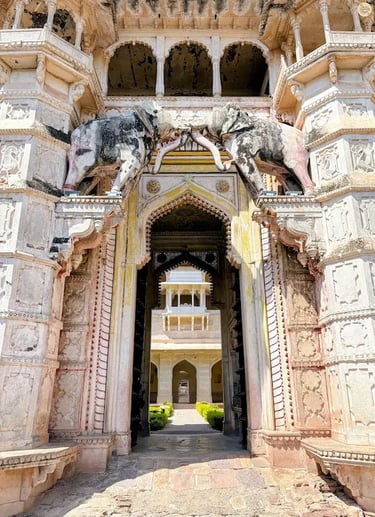

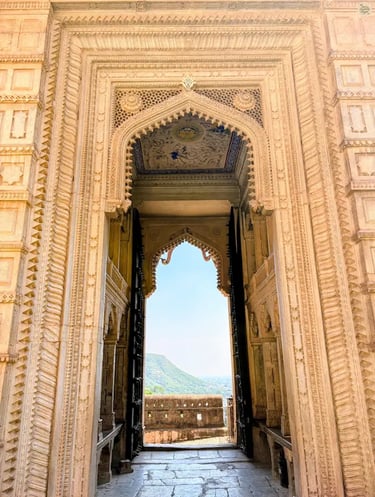
The grand Hathi pol seen from within the fort.
Ratan Daulat — The Royal Hall of Audience
Inside lies Ratan Daulat, or the Diwan-e-Aam, where kings once addressed their subjects. The vast hall glows with torch niches in its walls and houses a single block of Makrana marble carved into a throne — the same marble used in the Taj Mahal. This is where history feels tangible, quiet, and grand.
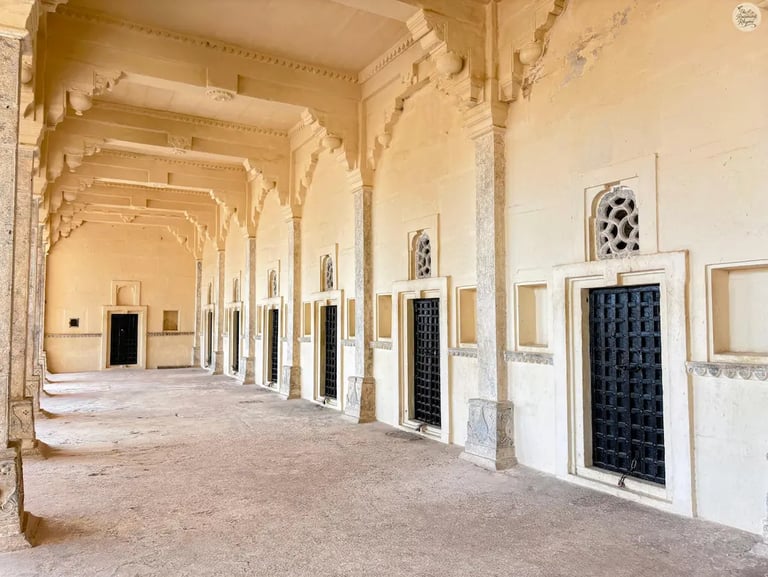

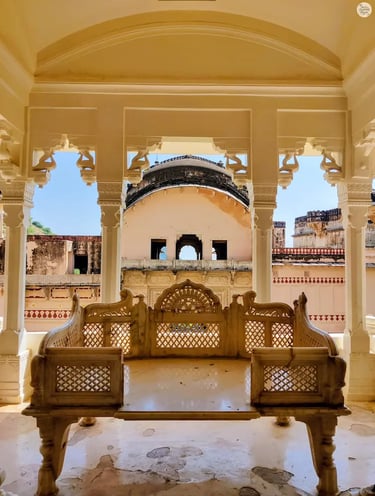

Ratan Daulat, the Diwan-e-Aam of Bundi Garh Palace.
Marble throne of Raja Ratan Singh at Ratan Daulat, Bundi.
Chattar Mahal — A Palace Painted in Stone and Story
Through a small doorway, you step into Chattar Mahal, built by Rao Chhatrasal Singh (1631–1658). Its large courtyard, centered with a fountain, opens into a hall supported by elephant-headed pillars — sculptures that double as engineering marvels, bearing the roof’s weight with perfect balance.
Elephant-shaped columns of the Baradari at Chhatar Mahal.
Framed by elephants, touched by history.
The opposite hall is a painter’s paradise — its walls bloom with Bundi-style murals in gold, indigo, and ochre. They tell tales from Hindu mythology and royal life, shimmering proof of Bundi’s once-prosperous past.
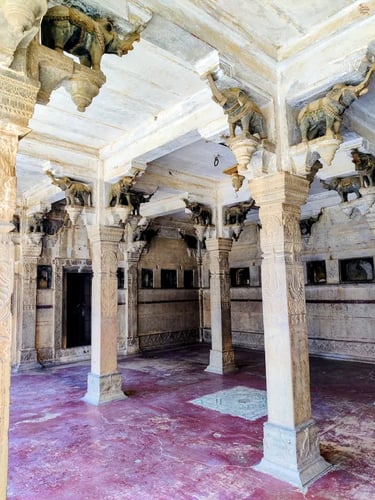

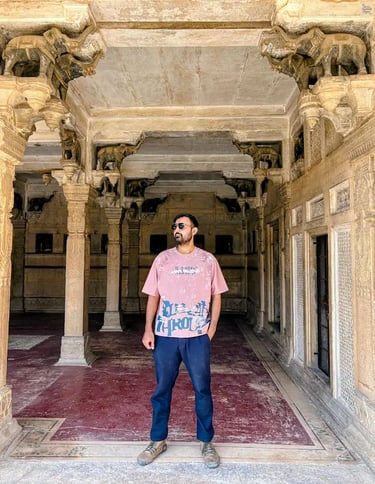

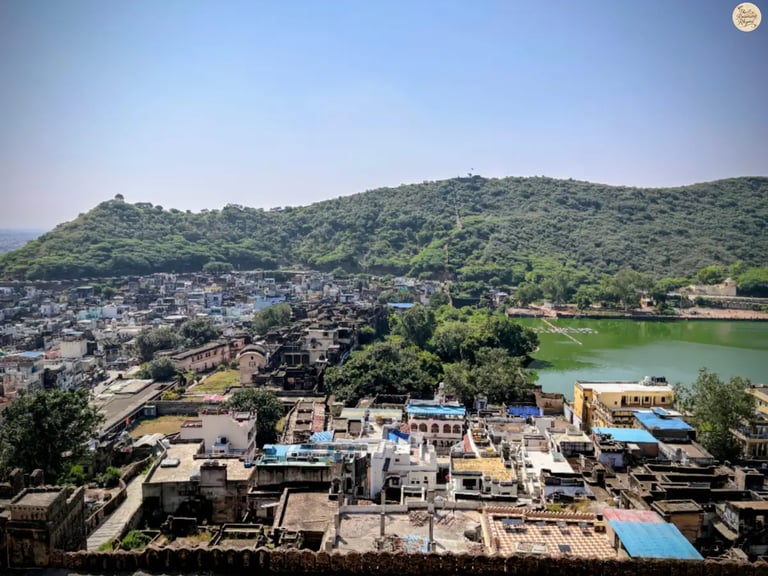

Panoramic view of Bundi town and Nawal Sagar Lake.
Phool Mahal — Where Walls Blossom with Art
A marked path leads upward to Phool Mahal, built by Raja Bhoj Singh III in 1607 AD as a residence for royal guests. True to its name, the palace blooms with floral frescoes, mirror work, and graceful arches. Sunlight dances on the walls, reflecting off tiny glass inlays that make the hall shimmer like a living garden. The paintings here show Bundi’s artistry at its finest — elegant lines, natural colors, and a calm beauty that once welcomed noble visitors in royal comfort.
Phool Mahal — where royal elegance blooms in frescoes, mirrors, and sunlight.
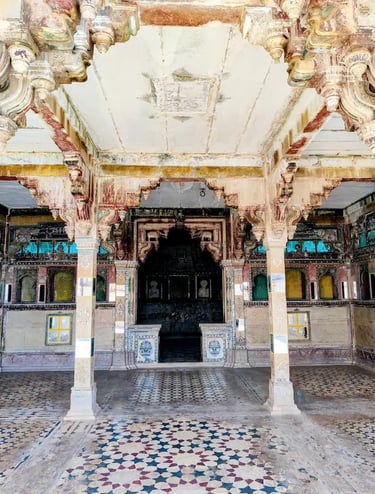

Badal Mahal — The Palace that Touches the Clouds
Further up stands Badal Mahal, perched at the highest point of the fort. During monsoons, clouds would drift through its open courtyards — hence the name. Its rooms glow with paintings that blend art and science: mica sheets for reflection, and Lapis Lazuli pigment ground from Persian stone to create that deep, dreamlike blue. These are among the finest miniature paintings in India — Bundi’s artistic soul preserved in pigment and plaster.
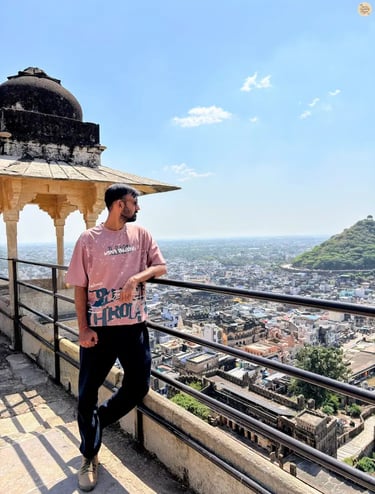

Capturing the panoramic view of the blue town of Bundi.
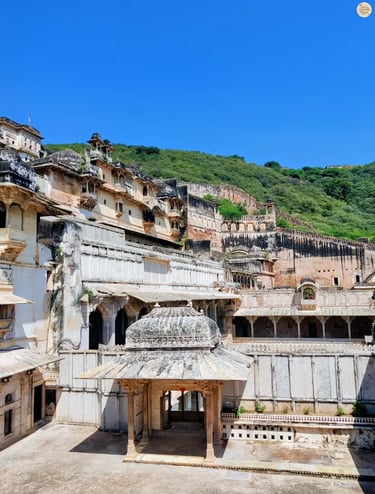

Grand layered architecture and royal charm of Garh Palace Bundi.
Jhula Chowk — The Courtyard Where Queens Once Swung
As you descend, you pass Jhula Chowk, where queens once swung beneath carved arches. Anchors still remain where royal swings once hung — a gentle reminder that even in grandeur, Bundi always left room for joy.
Garh Palace Bundi is not just a monument — it’s a layered poem in stone. Every hall, gate, and mural hums with echoes of royal footsteps, and every turn reveals a new secret of Rajasthan’s artistic heart.
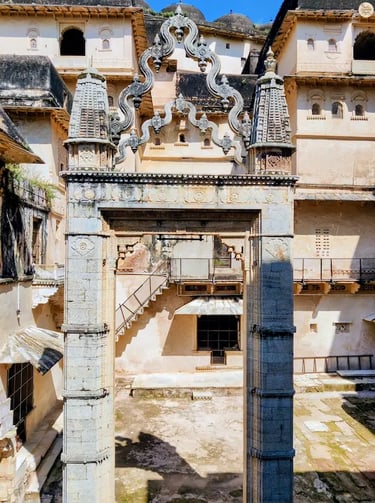

Where queens once swayed in royal grace.
Chitrashala — Where Bundi’s Walls Whisper in Color
A steep stone ramp leads you to Chitrashala, meaning School of Art, one of the most enchanting corners of Taragarh Fort Bundi. This open pavilion, with arched windows and cool breezes, houses a mesmerizing collection of Bundi Miniature Paintings — delicate, detailed, and drenched in shades of green and blue.
The walls come alive with scenes from Lord Krishna’s life — lifting the Govardhan Parvat, dancing the Raas Leela with Radha and the Gopis, and playfully stealing their clothes by the river Yamuna. Each panel is rich with emotion, movement, and masterful brushwork.
Between myth and daily life, the artists also captured the charm of royal women, gardens, and musicians — small glimpses of Bundi’s elegant past. Time has faded the colors, but not the soul. Standing here, surrounded by stories in pigment and stone, you feel why Chitrashala Bundi remains one of Rajasthan’s most treasured artistic legacies.
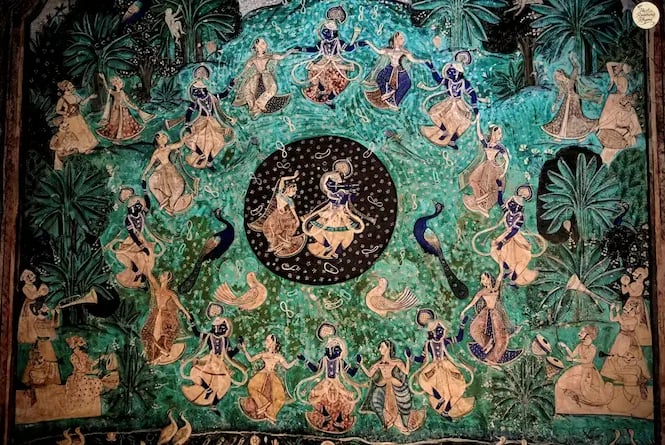

Ras Leela mural of Lord Krishna and Radha at Chitrashala .
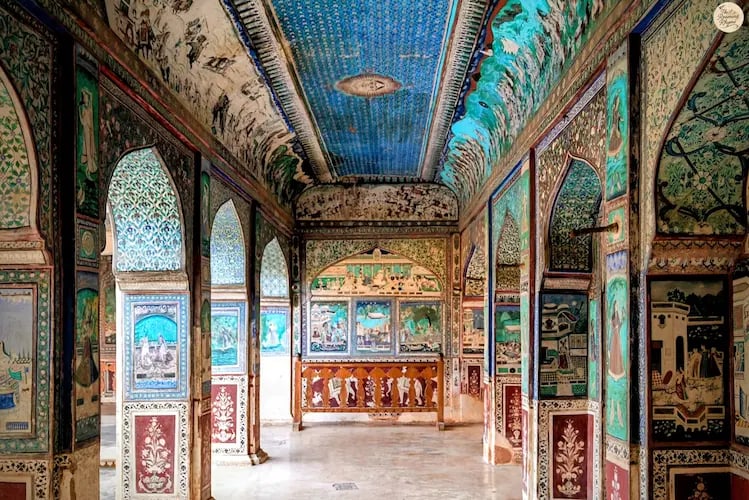

Chitrashala adorned with vibrant frescoes and miniature paintings.
Uphill Ruins of Taragarh Fort — Where Time Sleeps on Stone
The trail above Garh Palace leads to the upper ruins of Taragarh Fort, a quieter stretch often missed by most visitors. The climb is steep and the path rugged, but it rewards you with sweeping views of Bundi and its blue lanes below.
Here you’ll find the weathered remains of Rani Mahal, old soldiers’ quarters, granaries, and ancient water reservoirs that once sustained the fort during sieges. Though much of it lies in silence and stone, the atmosphere carries a haunting charm — echoes of centuries past under open Rajasthani skies.
Among the bastions, Bhim Burj stands out as the largest and most imposing. It once held the legendary cannon Garbh Ganjan, whose thunderous roar was said to shake the earth — earning it a name that translates to “the sound that could unsettle a womb.” This mighty weapon was considered the second-largest cannon in India, after the famous Jaivana of Jaigarh Fort in Jaipur.
Today, the upper ruins of Taragarh Fort Bundi may be quiet, but they remain steeped in mystery — a place where wind, stone, and legend still keep watch over the town below.

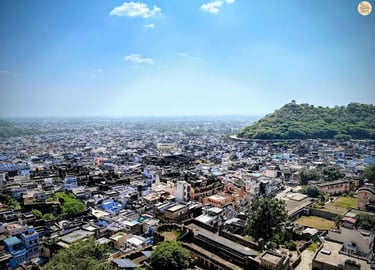
Bundi sprawls below — blue, bright, and timeless.
As you leave the parking lot at Taragarh Fort and ease into the old lanes of Bundi, you’ll notice art studios dotting the narrow alleys — each specializing in the famed Bundi School of Painting. This celebrated style of Rajasthani miniature art originated in the 17th century in the princely state of Bundi.
The paintings are more than just decoration. Through the vivid colours and meticulous brush-work, they portray royal life, festivals, battle scenes, horse races and scenes of everyday life in Bundi. These works serve as a window into the social, cultural and religious worlds of their time.
Among the many art studios lining the lanes, one that stands out is Yug Art Studio, run by local artist Yug Prasad. Widely admired both in India and abroad, Yug keeps this royal art form alive with a contemporary touch. Beyond traditional miniatures, he creates portraits in Bundi style — transforming simple photographs into regal works of art — as well as caricatures and comic-style illustrations that fuse heritage with humor.
A visit here isn’t just about buying art — it’s about meeting a keeper of Bundi’s legacy, watching him paint fine details with the same patience and precision passed down through generations. If you love culture, color, and craft, this stop will leave you truly inspired.
Bundi Miniature Painting — The Living Art of a Bygone Era
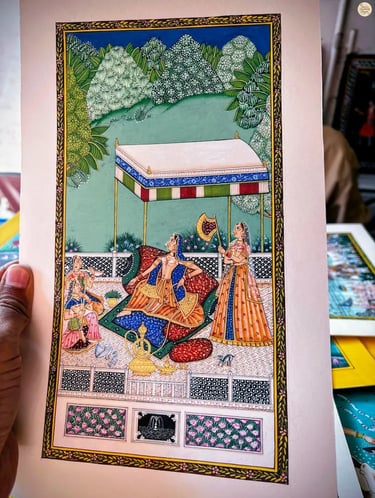

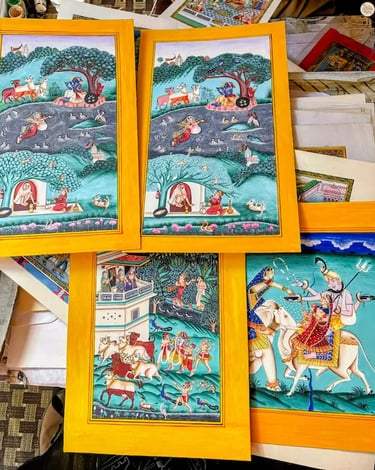

Art So Delicate, It Feels Alive
Fine Brush, Timeless Stories — Bundi Miniature Art
You might wonder why a tea stall finds its way into a list of Bundi’s top attractions — but Krishna’s Tea Stall isn’t just a stop; it’s an experience. What began as a humble corner for chai has grown into one of Bundi’s most loved spots, often called the “Best Tea in India” by travelers from more than 50 countries. Their colorful stamps, doodles, and postcards cover the tiny shop’s walls — a mosaic of memories left behind.
At first glance, it looks like any other tea shop, but step inside and the air changes — the aroma of spices, the soft hum of chatter, and the gentle warmth of Bundi’s hospitality fill the room. It’s a place to sip tea with a book, meet strangers who become friends, or simply sit back and let the world slow down.
The tea itself is the heart of it all — each cup brewed with care. From the bold Masala Chai that hugs your senses to the Lemon Red Tea that soothes your soul, every sip feels personal. Don’t miss Krishna’s specials like Saffron Hot Milk and Special Indian Tea — both local legends in their own right.
But what truly makes Krishna’s Chai unforgettable is its spirit. It’s more than a café — it’s a community hub, a cozy corner of the world where travelers, locals, and dreamers come together over stories and laughter. The tiny space fits barely ten people, but that closeness adds to its charm. Shoes are left at the door, smiles are shared freely, and time somehow stretches.
Krishna himself smiles more than he speaks — pouring calm and kindness with every cup. His little shop, with its humble walls and open heart, captures the very essence of Bundi’s soul — proof that sometimes, it’s the smallest places that leave the biggest impressions.
Krishna’s Chai — The Soulful Sip of Bundi
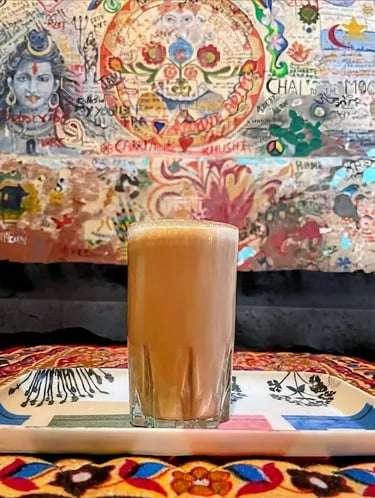


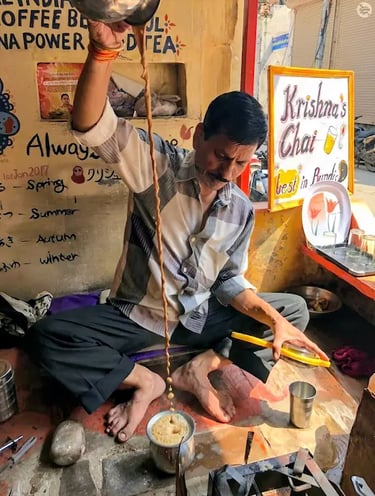
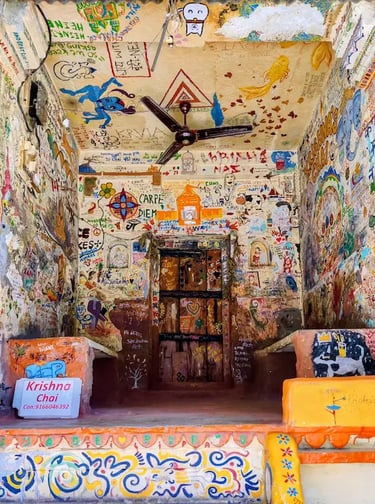

Steaming masala chai at Krishna’s Tea Stall
Krishna brewing his famous tea at his tiny stall in Bundi
A Canvas of Chai Memories
The town of Bundi is often called the City of Stepwells, and among its fifty-odd baoris, none is as grand or graceful as Raniji ki Baori — The Queen’s Stepwell. Just 2 km from Taragarh Fort Bundi, this architectural gem was built in 1699 by Rani Nathavati Ji, the younger queen of Maharao Raja Anirudh Singh.
At 46 metres deep, the stepwell descends into the earth like a carved poem in stone. Its multi-storeyed design features finely sculpted pillars, high-arched gateways, and symmetrical steps that play beautifully with light and shadow. As you step inside, stone elephants stand guard at the entrance, while smaller shrines appear at every level — places where travelers once offered prayers before drawing water.
But Raniji ki Baori was more than just a water reservoir; it was once the heart of Bundi’s community life. During dry months, locals gathered here — women filling pots, children playing on the cool steps, and elders sharing stories under the carved arches. The air stays cooler inside, and even today, the quiet hum of the stepwell feels like a retreat from Rajasthan’s heat.
Every detail — from the latticework panels to the floral motifs — reflects the finesse of 17th-century Bundi architecture and the royal patronage of its queens. Raniji ki Baori Bundi stands not just as a marvel of engineering, but as a symbol of grace, generosity, and the timeless bond between art and everyday life.
Raniji ki Baori — The Queen’s Stepwell of Grace and Grandeur
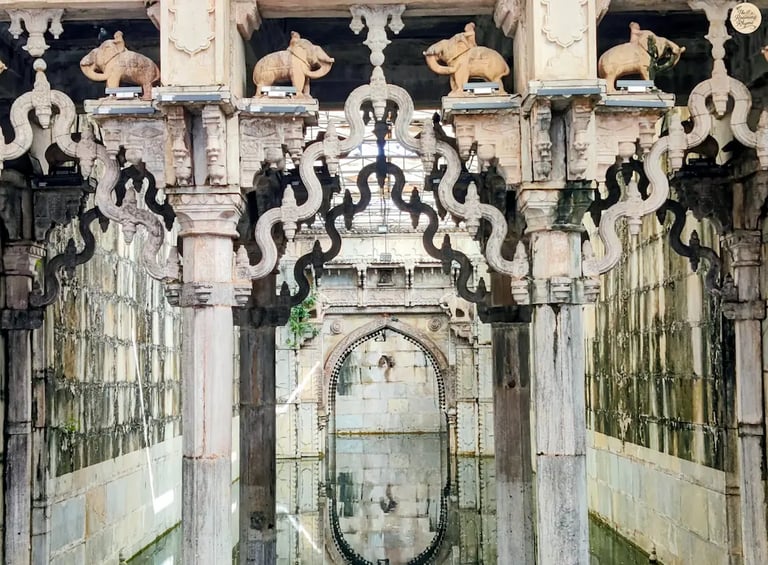

When Arches Meet Their Mirror
🕒 Raniji ki Baori Timings & Entry Fee
Timings: Daily 9:00 AM – 5:00 PM
Entry Fee:
Foreign Tourists: ₹200 for one & ₹350 for two.
Indian Tourists: ₹50 for one & ₹75 for two.
Student: ₹5 (for Indians) & ₹20 (for foreigners).
💡 Note: Tourists can buy a combo ticket for ₹75 and explore Rani ji ki Baori, Chaurasi Khambon ki Chhatri, and Sukh Mahal.
Just a two-minute drive from Raniji ki Baori lies another remarkable stepwell — Dhabhai Kund, also known as the Dhabhai Stepwell. The word Dhabhai means “foster brother,” derived from Dhai, or “foster mother.” Built in 1658 by King Rao Bhoj of Bundi, the stepwell was dedicated to his foster brother — a touching symbol of loyalty and affection within the royal household.
Dhabhai Kund Bundi stands out for its striking square shape and unique design, with a series of intricately carved staircases descending symmetrically toward the water. One side of the stepwell features small rooms and platforms, believed to have been used for rest and shade.
The architectural precision here reflects the brilliance of Rajput engineering — blending beauty, geometry, and practicality. Even in its quiet simplicity, Dhabhai Kund tells stories of Bundi’s devotion to water conservation and artistic craftsmanship. For travelers and history enthusiasts, it’s a serene reminder of how deeply art and emotion once flowed through everyday life in Rajasthan.
Dhabhai Kund — The Stepwell of Brotherhood

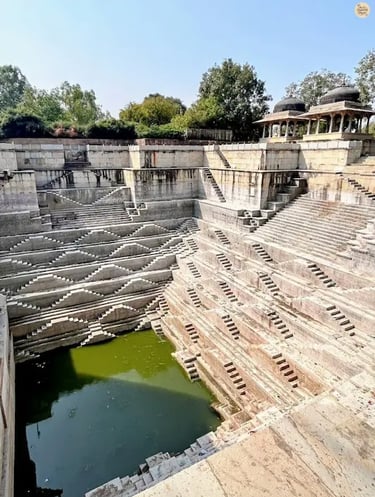
Perfect symmetry — the timeless geometry of Dhabhai Kund.
🕒 Dhabhai Kund Timings & Entry Fee
Timings: Daily 9:00 AM – 5:00 PM
Entry Fee: No Entry Fee
A few kilometers from Dhabhai Kund, another architectural wonder awaits — the Chaurasi Khambon ki Chhatri, or 84-Pillared Cenotaph. Built in the 17th century by Rao Raja Anirudh Singh of the Hada Chauhan dynasty, this grand cenotaph was dedicated to his foster brother Deva, who once ruled over Bundi.
As the name suggests, the structure is supported by Eighty-Four Intricately Carved Pillars, each different from the other, showcasing the artistry of Rajput stone craftsmanship. Beneath its large domed canopy rests a Shivling, symbolizing devotion and eternity.
The ceiling of this elegant pavilion is adorned with frescoes and murals in the Bundi style, depicting Hindu gods, goddesses, and mythological motifs in fading yet graceful colors. Each pillar is etched with floral and geometric designs, and some bear carvings of dancers, musicians, elephants, and deer — life and faith captured in stone.
The number 84 itself holds deep significance in Hindu belief, representing the 84 lakh life forms a soul must pass through before attaining human birth. Thus, Chaurasi Khambon ki Chhatri Bundi stands not just as a royal memorial, but as a symbol of the spiritual journey — where art, devotion, and architecture meet in perfect harmony.
Chaurasi Khambon ki Chhatri — The 84-Pillared Cenotaph
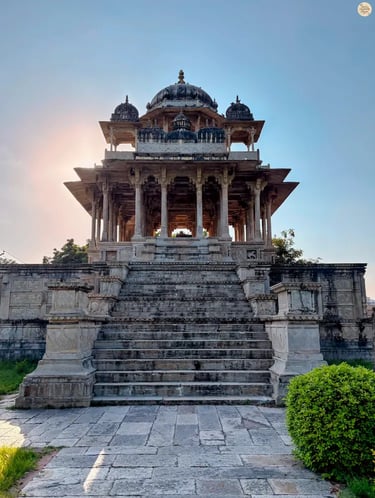

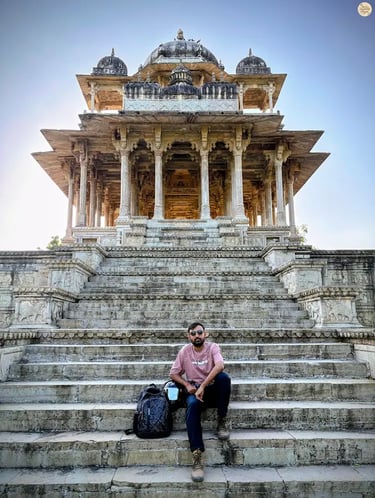

Where Pillars Tell Ancient Tales
Eighty-Four Pillars, One Eternal Story

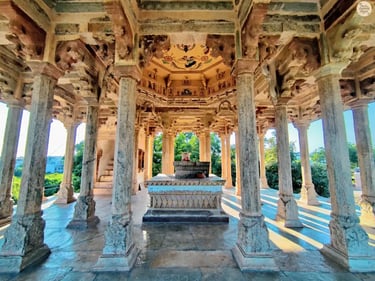
Sacred Shivalingam inside the Chaurasi Khambon ki Chhatri
🕒 Chaurasi Khambon Ki Chhatri Timings & Entry Fee
Timings: Daily 9:00 AM – 5:00 PM
Entry Fee:
Foreign Tourists: ₹200 for one & ₹350 for two.
Indian Tourists: ₹50 for one & ₹75 for two.
Student: ₹5 (for Indians) & ₹20 (for foreigners).
💡 Note: Tourists can buy a combo ticket for ₹75 and explore Chaurasi Khambon ki Chhatri, Sukh Mahal, and Rani ji ki Baori.
The next gem on your Bundi itinerary is Sukh Mahal, meaning Palace of Pleasure. Built in 1776 A.D. during the reign of Rao Raja Vishnu Singh, under the supervision of his Diwan and architect Sukhram, this elegant retreat served as the royal family’s summer residence.
Perched on the serene banks of Jait Sagar Lake, Sukh Mahal was designed with remarkable ingenuity — its arched corridors and airy verandas channel the cool lake breeze through the palace, creating a natural cooling effect that offered relief from Rajasthan’s harsh summers. The setting, with its reflection shimmering in the lake, embodies the quiet grace of Bundi’s royal past.
Beyond its architectural charm, Sukh Mahal also holds a literary connection. The British author Rudyard Kipling stayed here during his visit to Bundi in the late 19th century. Enchanted by the palace’s tranquil beauty, he drew inspiration from it for scenes in his celebrated novel “Kim.”
With its blend of art, engineering, and romance, Sukh Mahal remains a symbol of Bundi’s timeless allure — a palace where poetry, history, and architecture meet by the lakeside.
Sukh Mahal — The Palace of Pleasure

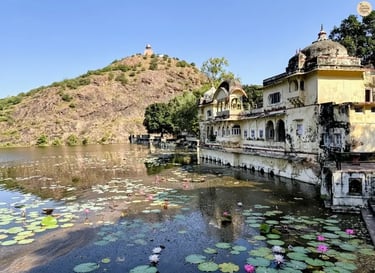
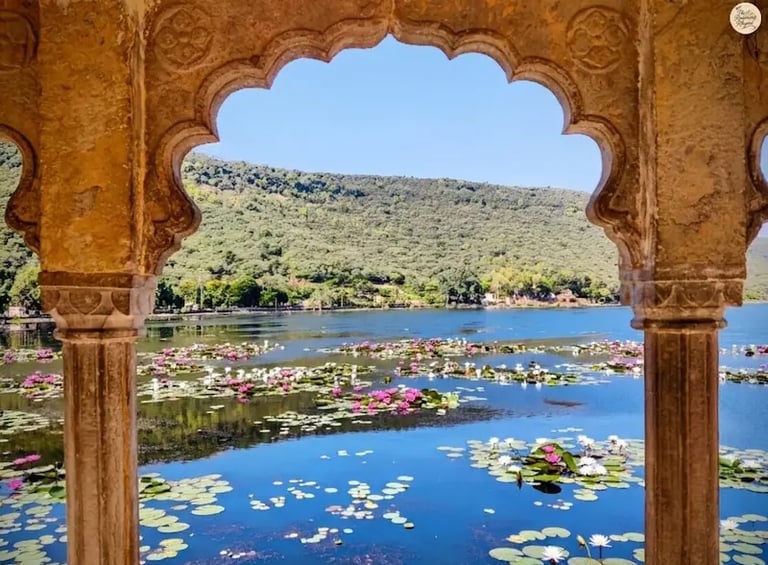


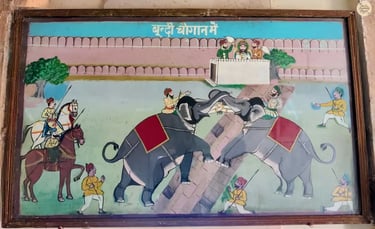
Bundi’s royal retreat by the rippling lake
Clash of Giants — Elephant Fight Scene from Bundi’s Sukh Mahal
Framing Jait Sagar Lake — A royal view through Sukha Mahal’s arches.
🕒 Sukh Mahal Timings & Entry Fee
Timings: Daily 9:00 AM – 5:00 PM
Entry Fee:
Foreign Tourists: ₹200 for one & ₹350 for two.
Indian Tourists: ₹50 for one & ₹75 for two.
Student: ₹5 (for Indians) & ₹20 (for foreigners).
💡 Note: Tourists can buy a combo ticket for ₹75 and explore Sukh Mahal, Chaurasi Khambon ki Chhatri, and Rani ji ki Baori.
Just a short walk from Sukh Mahal, within the same complex, lies the Government Museum of Bundi — a quiet yet fascinating stop for history lovers. The museum showcases Bundi’s rich legacy through its collection of arms, sculptures, manuscripts, and Miniature Paintings from the Bundi and Kota schools of art.
Inside, you’ll find an array of swords, katars, shields, guns, and powder flasks, along with prehistoric stone and copper tools, reflecting the craftsmanship and warfare traditions of Rajasthan’s bygone eras.
Outside the Sukh Mahal, an open-air display of ancient stone sculptures adds another layer of intrigue. These relics were dredged from the River Chambal at Keshoraipatan, an ancient sacred site in Bundi district. According to tradition, damaged idols couldn’t be discarded, so they were gently immersed in the river. Over the years, local sand miners discovered and preserved them — giving Bundi’s museum an extraordinary riverside legacy of devotion and artistry.
Government Museum Bundi — A Glimpse into the Royal Past
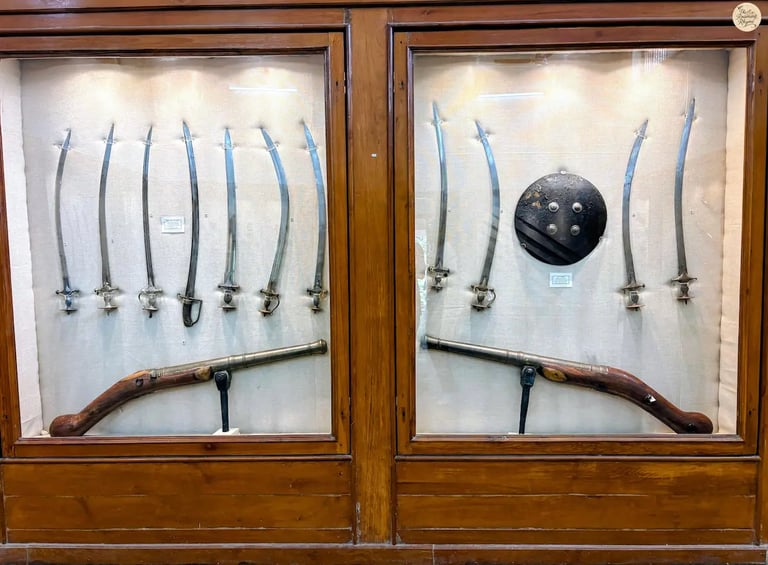

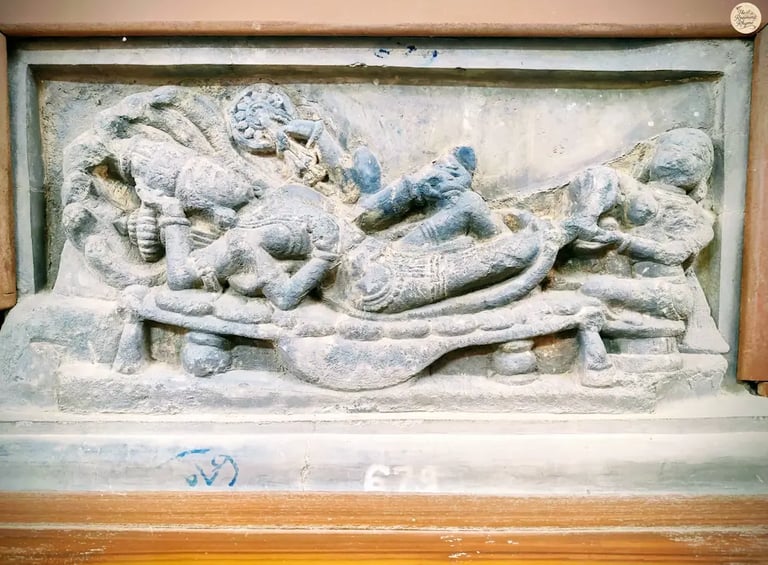

The Armory of Forgotten Battles
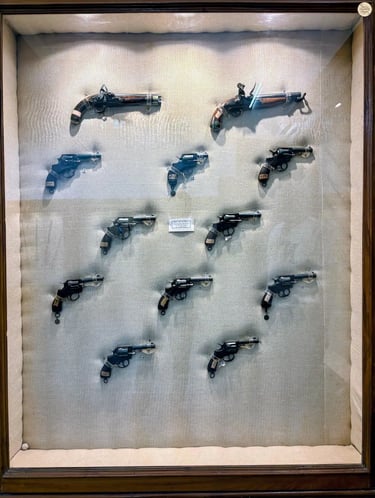

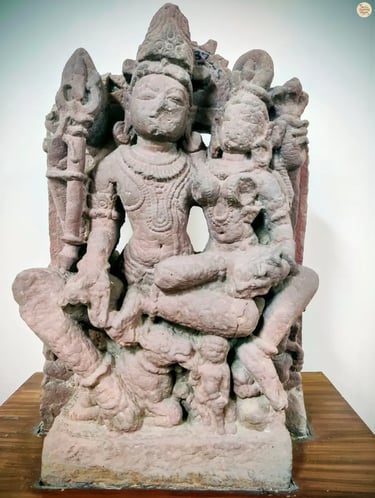


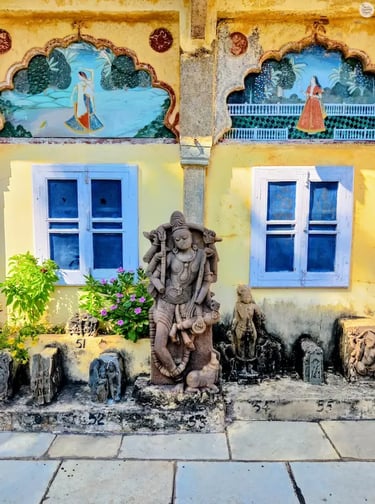
Echoes of Bundi’s Battle Days
Intricate sculpture of Lord Vishnu resting on serpent Sheshnaga, attended by Goddess Lakshmi.
Echoes in Stone — Stone Figures of Bundi Museum
Stone idols and artifacts recovered from the River Chambal on display
After a day exploring Bundi’s forts, palaces, and stepwells, unwind with dinner at a rooftop restaurant overlooking Taragarh Fort. As night falls, the fort glows gold over the blue town — a timeless view wrapped in cool breeze and calm.
As the day winds down and the lights of Taragarh Fort shimmer over the blue lanes, Bundi begins to hum its quiet evening tune. There’s a rhythm here — in the ripples of Nawal Sagar, in the brushstrokes of its artists, in the steam rising from Krishna’s chai. Every corner tells a story, not in grandeur, but in grace.
Bundi isn’t just a place to see — it’s a place to feel. The forts whisper old courage, the stepwells echo laughter of another time, and the lakes mirror a beauty that never fades. Whether you’re chasing murals, sipping tea, or just watching the sunset paint the walls gold, Bundi reminds you to slow down, to breathe, to wander without hurry.
Because Bundi isn’t meant to be ticked off an itinerary — it’s meant to be lived, one roaming rhyme at a time.
Frequently Asked Questions – Bundi Travel Guide
Q. What is Bundi famous for?
A. Bundi is known for its stepwells, blue lanes, forts, and Bundi miniature paintings. It’s often called the City of Stepwells, home to Raniji ki Baori, Garh Palace, and Taragarh Fort — places where history and art still breathe.
Q. Is it worth visiting Bundi, Rajasthan?
A. Yes — Bundi is a hidden gem of Rajasthan. It’s quieter than Jaipur or Udaipur, yet full of charm — from fresco-filled palaces to peaceful lakes and timeless streets that whisper old tales.
Q. What to buy in Bundi, Rajasthan?
A. Shop for Bundi Miniature Paintings, handmade postcards, Kota Doria Sarees, and local handicrafts. Visit Yug Art Studio for authentic art that keeps Bundi’s royal tradition alive.
Q. How much is a taxi from Kota to Bundi?
A. A taxi from Kota to Bundi (36 km) costs around ₹1,000–₹1,500. The scenic one-hour drive passes through rustic countryside — perfect for a short road trip.
Q. Best Food to Try in Bundi?
A. Don’t miss Rajasthani thali, kachori, and lassi. At Krishna’s Tea Stall, try the iconic Masala Chai or Saffron Hot Milk — both local legends.
Q. What are the best photography spots in Bundi?
A. Top spots include Nawal Sagar Lake, Raniji ki Baori, Garh Palace, Chitrashala, and the fort terrace view overlooking the blue town below.
Q. Most Instagrammable spots in Bundi?
A. Capture sunrise at Nawal Sagar, arches of Raniji ki Baori, graffiti at Krishna’s Tea Stall, and sunset over Taragarh Fort — Bundi’s magic in every frame.
Q. Is there a tourist guide service available in Bundi?
A. Yes, Bundi has a few licensed local guides who bring the city’s stories to life. One of the most recommended is Ashwani Sharma (Kukki Junior) — a government-approved guide known for his deep knowledge of Bundi’s forts, stepwells, and murals. With a post-graduate degree in History and a diploma in Heritage Tourism and Archaeology, he offers insightful and engaging tours.
Q. What’s the best way to get around internally in Bundi?
A. In Bundi’s old town the easiest and most local-friendly mode is auto-rickshaw (often called ‘auto’) or three-wheelers — short rides cost around ₹30–80 depending on distance. Walking the blue lanes also works well since many attractions are close-by and the streets are narrow.
Share Your Thoughts – We’d Love to Hear From You!
Every journey is better when shared.
We hope you enjoyed this travel story — now, we'd love to hear yours! Share your experience, suggestions, or feedback and help us make our travel tales even better.
